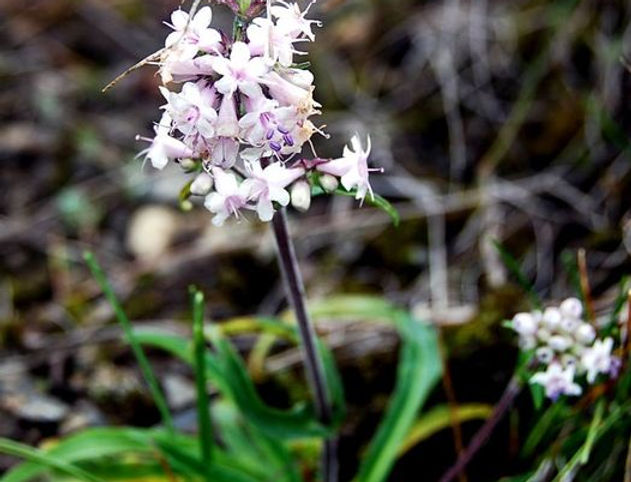WHISPERS OF THE WOODS

The Masi Flower captured in the hills of Pithoragarh in Uttarakhand. Image Courtesy: Vinod Upreti from Kafaltree.com
Masi
The aromatic flower of Masi or Jatamasi (Nardostachys jatamansi) is widely popular in Uttarakhand. The plant is found at an altitude of 3,000–4,000 m. It is generally found clinging on to steep rocky cliffs and grassy slopes or in wet meadows and by the banks of the rivulets in the high valleys (Shah 9). It flowers in the month of July to August.
मासी का फूल or the flower of Masi is considered auspicious and hence offered to the gods. It is believed that the flower is so aromatic that when uprooted from the soil by hand its sweet fragrance is absorbed in the palm (Shah 9). A popular folk story known to the locals is about a conversation between two people — one who knows the details (Knowledgeable Person) and the other does not (Ignorant Person). The two are exchanging knowledge about the flower.
Ignorant Person: There is a rivulet in Serakhet. Where is the masi flower found?
Knowledgeable Person: The masi flower is found in the high alpine region of the Himalayas, where green meadows (बुग्याल or bugyal), where there are forests of poison.
Ignorant Person: What are the characteristics of the flower?
Knowledgeable Person: Sometimes the flower starts smiling. Sometimes it droops down. It is white in colour. It flowers in the रंगीन मैण or rangeen maen (“the colourful month”) of असोज or asoj (September-October),
Ignorant Person: Who is that young man (as it is found in difficult terrain, it can be accessed by the young) or lucky one who will bring the masi flower?
Knowledgeable Person: The masi flower will be brought by the shepherd of the Anwal tribe of the mobile migrating shepherd tribe.
Ignorant Person: To which deities is this flower offered?
Knowledgeable Person: The flower will be first offered to खोली का गणेशा or the Ganesh of the kholi. It will then be offered to Bhumiya, Isht Malaynath Swami, Gaura-Maheshwar, Badri Kedar, Hari at Haridwar, Goddess Bhagwati, and then to all the other deities.
In India, it is listed as threatened species and is a critically endangered species in the Kumaon region (Airi et al., 2000). Given the significance of the flower, the plant has been heavily exploited leading to its depletion and endangerment.
The list of songs on the flower is as follows:
1. "Masi ko Phool" by Prahlad Mehra
2. “Masi ko Phool” by Darshan Farswan
3. “Raimasi ko Phool” by Narendra Singh Negi
4. “Masi ka Phool” by Upreti Sisters
5. “Remasi ko Phool” by Rajni Rana
6. “Masi ko Phoola” by Sher Singh Mehar and Babita
7. “Masi ku Phuna” by Darwan Naithwal and Meena Rana
Note: The copyright for the videos rests with the content creators on the hosting platform, YouTube.
Glossary:
Anwal: One of the two (the Bhotia tribe is the other) native Hindu tribes co-inhabiting the Namik Valley of Uttarakhand. The mobile migrating shepherd tribe is only found in the hilly forested and remote area of Uttarakhand.
असोज or asoj: The seventh month of the lunisolar Hindu calendar or also referred to as Ashwin (September-October).
बुग्याल or bugyal: Refers to the large swathes of alpine pasture pasture lands, which are generally found at an altitude of 3,300m — 4,000m. (For details, visit Visual Glossary).
खोली का गणेशा or the Ganesh of the kholi: The reference here is to the idol of Ganesh usually fixed at the top of the entrance of the traditional houses in the hills such that one bows to the god as one enters inside.
Works Cited:
Airi, S., et al. “Assessment of Availability and Habitat Preference of Jatamansi — A Critically Endangered Medicinal Plant of West Himalaya.” Current Science, vol. 79, no. 10, 2000, pp. 1467–71. JSTOR, http://www.jstor.org/stable/24105109. Accessed 9 Apr. 2024.
Burfield, Tony. “Unethical use of rare and threatened plant and animal products.” Endangered Species, vol. 20, no.3, 2003, pp.97–106.
Shah, Niranjan Chandra. “On the history, botany, distribution, uses and conservation aspects of Nardostachys jatamansi in India.” Medicinal Plant Conservation, vol.13, Dec. 2007, pp.8–11.
Musical Rendition
About
It is a traditional folk song of Uttarakhand, sung by the local community during fairs and festivals in the Kumaon region. It is a chanchari song, which is sung during khel and is integrated with dance rhythm.
Music: Traditional Folk
Lyrics: Traditional Folk
Dholak: Ashish Manola
Harmonium: Laxman Singh Manola
Vocalists: Laxman Singh Manola and Pooja Manola